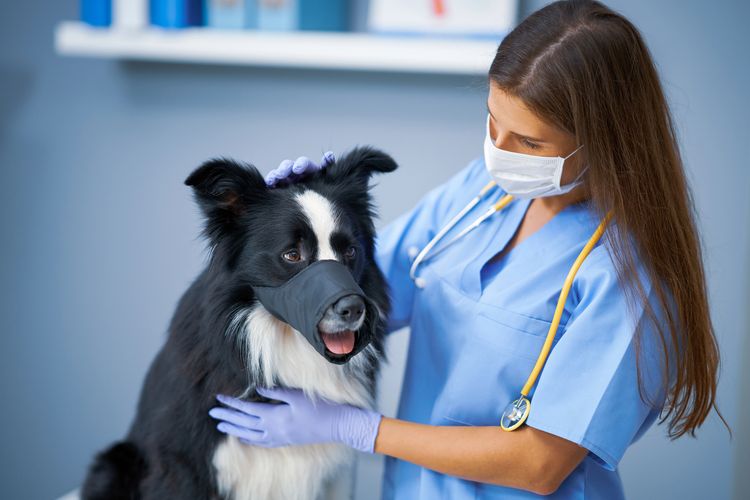First the cause, then the solution
Behavioral problems can have many causes - from physical ailments to psychological stress and environmental factors. A thorough and systematic analysis is crucial in order to understand the dog correctly and be able to help it. This includes a veterinary examination to rule out physical triggers - even if it appears to be "just" a health problem that the dog tolerated without any problems in the past.
Do not judge too quickly
It is a common mistake to hastily attribute a dog's behavior to training mistakes or a supposedly too "compliant" attitude on the part of the caregiver. Although boundaries and clarity can be important, pressure or strictness will not solve deep-seated problems. On the contrary: if symptoms are only suppressed, for example through intimidation, subliminal anxiety can build up - with the risk that the undesirable behavior will reappear in a different form.
It is also important to be aware that conspicuous behavior is not an expression of disobedience or malice. Dogs do not act arbitrarily - they react to internal or external influences that they themselves are unable to classify or communicate. A helpful reaction therefore means understanding, patience and a professional approach, not rashly assigning blame - neither to the owner nor to the dog.
The most important questions at a glance
1 What are behavioral problems in dogs?
Behavioral abnormalities are behaviors that deviate from a dog's normal, socially acceptable behavior - e.g. excessive barking, aggression, fear, destructiveness or uncleanliness.
2 How can I tell if my dog has behavioral problems or is simply "peculiar"?
If the behavior occurs regularly, seems extreme or significantly interferes with living together, it should be observed more closely or professionally assessed.
3. can health problems be the cause?
Yes, many behavioral problems have physical causes, e.g. pain, neurological diseases or hormonal disorders. A visit to the vet is therefore an important first step.
4 What can I do if my dog shows conspicuous behavior?
A comprehensive assessment is important: first medical, then behavioral therapy. Veterinary behavioral therapists or experienced dog trainers can provide targeted help.
5 Is it my fault if my dog has behavioral problems?
Dogs are complex creatures with individual experiences, genetic factors and environmental conditions. In many cases, behavioral problems occur without the influence of the owner.
6. can conspicuous behavior be "trained away"?
With patience, appropriate support and individualized training, many problems can be significantly improved - but sometimes management or long-term care is required.
7 When should I seek professional help?
If the behavior is stressful - for you, your dog or the environment - professional help is advisable. The sooner, the better.
When behavior suddenly changes
If a dog suddenly behaves differently, this is an important signal that should not be ignored. If a dog suddenly shows anxiety, aggression, withdrawal or unusual reactions, you should take notice. Such changes often have a specific trigger. In these moments, it is very important to observe the dog closely and make a note of important information about the behavior so that you can intervene as quickly as possible and get help efficiently.

How can you recognize a behavioural problem in a dog?
Not every undesirable behavior is automatically a behavioral disorder. Dogs exhibit completely natural, often breed- or age-related behaviors that are completely normal in a certain context. However, we speak of a behavioral abnormality when the behavior goes beyond the usual level, occurs regularly and becomes problematic for both the dog and its environment. Examples include excessive barking, prolonged pulling on the lead or anxiety.
What is a behavioral disorder?
In contrast, a behavioral disorder describes a much more serious problem: It is present when the behavior is pathological and permanently derailed and lies outside the normal behavioral repertoire - comparable to mental illnesses in humans. Such disorders usually require in-depth veterinary or behavioral therapy.
Reasons for behavioral abnormalities
Not every change in behavior has the same basis. It is not always possible to pigeonhole them: Physical, emotional and learned factors often overlap - or are even mutually dependent.
Some dogs simply appear ill-mannered, for example when they use furniture, bark or constantly jump up - this can often be caused by a lack of training. But this can also be deceptive: Such behaviors can also result from inner stress or excessive demands. Other animals show behavioral problems even though they are physically healthy - they react excessively to stimuli, appear anxious, irritable or overwhelmed. These dogs are often emotionally stressed, for example due to bad experiences or a lack of socialization. In such cases, targeted behavioral training helps, which is not aimed at obedience but at stress reduction and emotional stability - in some cases also with medication.
It becomes particularly complex when physical and emotional stress are combined. Some dogs also develop physical complaints as a result of prolonged emotional stress - others only show conspicuous reactions after a physical illness, such as pain, persistent discomfort or hormonal imbalances. In both cases, a holistic approach is necessary: medical treatment and behavioral therapy support go hand in hand. It is important to take even seemingly minor health problems seriously, as they can have a major impact on behavior.
Last but not least, there are also cases in which the dog's behavior deviates extremely from normal behavior, for example in the case of neurological diseases. If an animal shows reactions that do not fit into the natural behavioral repertoire of a dog - or appear inexplicably bizarre - careful medical clarification is necessary, especially with regard to the nervous and endocrine systems.
So whether it is "just" training errors, emotional causes or an illness - or a combination of all of these: conspicuous behavior should always be considered in a differentiated way in order to be able to help the dog in a targeted and sustainable manner.

How necessary is it to act immediately?
Immediate action is required if the behavior has a massive impact on everyday life - for example, if the dog endangers people or other animals, is under severe stress, injures itself or the owner can hardly cope with everyday life. You should also be alert if the dog suddenly changes its behavior without a recognizable trigger. In such cases, it is important to first rule out physical causes before starting targeted behavioral training. If you act early, you will not only protect your dog, but also the harmonious coexistence in everyday life.
Examples of such problems
There are numerous situations in which it is just as important to seek professional help for behavioral problems as it would be for physical complaints. This is because psychological and emotional stress in dogs can lead to chronic stress, suffering and restrictions in everyday life in the long term - both for the animal and for the caregiver.
Examples where it is better to act too early than too late:
Sudden aggression towards people or other dogs
Strong anxiety behavior, e.g. at noises, people or in traffic
Destructive behavior in the home, especially if it is related to stress or being alone
Excessive barking or howling that no longer seems controllable
Compulsive behaviors such as excessive licking, chasing light reflexes or tail twisting
Withdrawal or apathy when the dog behaves conspicuously passive
Sudden uncleanliness, although the dog is actually house-trained
Poor impulse control or constant revving up in everyday situations
Such abnormalities are not just "bad training" or a phase, but can be an indication of an underlying problem - comparable to pain or fever in a physical illness. Even if the behavior initially "only" seems disruptive, it can become entrenched or worsen without help. Early advice from a specialist not only helps to avoid unnecessary suffering, but often also to prevent costly long-term therapies.
So what should be done?
Behavioral changes in dogs are valuable indicators of their well-being. They deserve attention and thorough clarification. Only if the cause is known can meaningful support be provided - be it through medical treatment, behavioral advice or changes in everyday life. A holistic view is the key to really doing your dog justice. You know your dog best: observe him closely and note when these behavioral problems occur.
A visit to a specialist
If a dog exhibits conspicuous behavior, it often makes the most sense to consult a behavioristor a trained specialist - in other words, someone who deals professionally with the interpretation and treatment of dog behavior on a daily basis. These experts can differentiate between harmless behavior, serious abnormalities and actual behavioral disorders. The assessment usually begins with a detailed questionnaire, which is filled out before the first appointment. Typical questions are asked such as: When does the behavior occur? How exactly does it manifest itself? In which situations? What has already been tried? It is also very helpful to bring video recordings of the behavior. This allows the specialist to get a realistic picture - because it is often not possible to reproduce the behavior in a practical setting. A well-founded diagnosis forms the basis for individual and targeted behavioral training, which ensures greater understanding and relief in everyday life in the long term.
All tips for action at a glance
If your dog suddenly shows conspicuous behavior, it is always worth taking a closer look - it is better to do too much than too little. This is because behavioral problems are not only stressful in everyday life, they can also be an indication of underlying physical or emotional causes. The sooner this is dealt with, the better the chances of a successful and sustainable solution. You should not hesitate to seek professional help - just as you would seek veterinary advice for health problems.
Important steps to take as soon as you notice a change in behavior:
Observe exactly when, how often and in which situations the behavior occurs
Make a written note of all abnormalities so that you can recognize patterns
Pay attention to changes: Is it getting worse, is it occurring more frequently, does the behavior change in certain contexts?
Make video recordings - they help professionals to better assess the situation
Seek advice from a professional trained in behavior therapy (veterinarian for behavior therapy or certified behavior trainer)at an early stage
This structured approach will provide you with a solid basis for a sound diagnosis and targeted support - for the benefit of your dog and for harmonious coexistence.
Sources and relevant links
del Amo C (2020). Hunde mit Verhaltensauffälligkeiten – „nur“ verwöhnt oder vielleicht krank?. team.konkret.
Barbara Schneider, Daphne Ketter (2016). Verhaltensmedizin bei Hund und Katze - Ätiologie, Diagnose und Therapie von Verhaltensproblemen. Schattauer.
Sabine Schroll, Joel Dehasse (2016). Verhaltensmedizin beim Hund - Leitsymptome, Diagnostik, Therapie und Prävention. Enke.
Patricia Solms (2020). Verhaltensprobleme beim Hund - Von den Grundlagen bis zum Management. Schlütersche Verlagsgesellschaft mbH & Company KG.



















